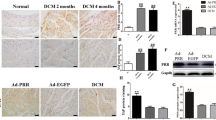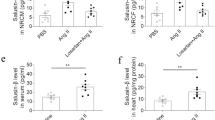Abstract
Myocardial fibrosis is a typical pathological manifestation of hypertension. However, the exact role of sirtuin 7 (SIRT7) in myocardial remodeling remains largely unclear. Here, spontaneously hypertensive rats (SHRs) and angiotensin (Ang) II-induced hypertensive mice were pretreated with recombinant adeno-associated virus (rAAV)-SIRT7, copper chelator tetrathiomolybdate (TTM) or copper ionophore elesclomol, respectively. Compared with normotensive controls, reduced SIRT7 expression and augmented cuproptosis were observed in hearts of hypertensive rats and mice with decreased FDX1 levels and increased HSP70 levels. Notably, intervention with rAAV-SIRT7 and TTM strikingly prevented DLAT oligomers aggregation, and elevated ATP7A and TOM20 expressions, contributing to the alleviation of cuproptosis, mitochondrial injury, myocardial remodeling and heart dysfunction in spontaneously hypertensive rats and Ang II-induced hypertensive mice. In cultured rat primary cardiac fibroblasts (CFs), rhSIRT7 alleviated CuCl2, Ang II or elesclomol-induced cuproptosis and fibroblast activation by blunting DLAT oligomers accumulation and downregulating α-SMA expression. Additionally, conditioned medium from rhSIRT7-pretreated CFs remarkably mitigated cellular hypertrophy and mitochondrial impairments of neonatal rat cardiomyocytes, as well as cell migration and polarization of RAW 264.7 macrophages. Importantly, verteporfin reduced CuCl2-induced cuproptosis, mitochondrial injury and fibrotic activation in CFs. Knockdown of ATP7A with si-ATP7A blocked cellular protective effects of rhSIRT7 and verteporfin in CFs. In conclusion, SIRT7 attenuates cuproptosis, myocardial fibrosis and heart dysfunction in hypertension through the modulation of YAP/ATP7A signaling. Targeting SIRT7 is of vital importance for developing therapeutic strategies in hypertension and hypertensive heart disorders.









Similar content being viewed by others
Data availability
No datasets were generated or analysed during the current study.
Abbreviations
- ANP:
-
Natriuretic peptide A
- ATP7A:
-
ATPase copper transporting alpha
- ATP7B:
-
ATPase copper transporting beta
- BNP:
-
natriuretic peptide B
- BSA:
-
Bovine serum albumin
- BW:
-
Body weight
- CCK-8:
-
Cell Counting kit-8
- CF:
-
Cardiac fibroblast
- Con:
-
Control
- CTGF:
-
Connective tissue growth factor
- CTR1:
-
Copper transporter 1
- Cu:
-
Copper
- DAPI:
-
4’,6-diamidino-2-phenylindole
- DLAT:
-
Dihydrolipoamide s-acetyltransferase
- DRP1:
-
Dynamin-related protein 1
- EF:
-
Ejection fraction
- ES:
-
Elesclomol
- FDX1:
-
Ferredoxin 1
- FS:
-
Fractional shortening
- GAPDH:
-
Glyceraldehyde-3-phosphate dehydrogenase
- HE:
-
Hematoxylin and eosin
- HSP70:
-
Heat shock protein 70
- HW:
-
Heart weight
- IL-1β:
-
Interleukin-1β
- IL-6:
-
Interleukin-6
- MFN2:
-
Mitofusin 2
- MMP2:
-
Matrix metallopeptidase 2
- MMP9:
-
Matrix metallopeptidase 9
- MPTP:
-
Mitochondrial permeability transition pore
- NAD+ :
-
Nicotinamide adenine dinucleotide
- NRCM:
-
Neonatal rat cardiomyocytes
- PMSF:
-
Phenylmethylsulfonyl fluoride
- rAAV:
-
Recombinant adeno-associated virus
- rhSIRT7:
-
recombinant human sirtuin 7
- RIPA:
-
Radio-immunoprecipitation assay
- ROS:
-
Reactive oxygen species
- SHR:
-
Spontaneously hypertensive rat
- siRNA:
-
small interfering RNA
- si-NC:
-
siRNA negative control
- SIRT:
-
Sirtuin
- TEM:
-
Transmission electron microscopy
- TL:
-
Tibia length
- TNF-α:
-
Tumor necrosis factor-alpha
- TOM20:
-
Translocase of outer mitochondrial membrane 20
- TTM:
-
Tetrathiomolybdate
- W:
-
Week
- WGA:
-
Wheat germ agglutinin
- WKY:
-
Wistar-Kyoto rat
- YAP:
-
Yes-associated protein
- α-SMA:
-
alpha-smooth muscle actin
- β-MHC:
-
beta-myosin heavy chain
References
Drazner MH (2011) The progression of hypertensive heart disease. Circulation 123:327–334. https://doi.org/10.1161/circulationaha.108.845792
Li J, Wang SY, Yan KX et al (2024) Intestinal microbiota by angiotensin receptor blocker therapy exerts protective effects against hypertensive damages. iMeta 3:e222. https://doi.org/10.1002/imt2.222
Sauve AA, Youn DY (2012) Sirtuins: NAD(+)-dependent deacetylase mechanism and regulation. Curr Opin Chem Biol 16:535–543. https://doi.org/10.1016/j.cbpa.2012.10.003
Li XT, Zhang YP, Zhang MW, Zhang ZZ, Zhong JC (2022) Sirtuin 7 serves as a promising therapeutic target for cardiorenal diseases. Eur J Pharmacol 925. https://doi.org/10.1016/j.ejphar.2022.174977
Winnik S, Auwerx J, Sinclair DA, Matter CM (2015) Protective effects of sirtuins in cardiovascular diseases: from bench to bedside. Eur Heart J 36:3404–3412. https://doi.org/10.1093/eurheartj/ehv290
Li XT, Song JW, Zhang ZZ et al (2022) Sirtuin 7 mitigates renal ferroptosis, fibrosis and injury in hypertensive mice by facilitating the KLF15/Nrf2 signaling. Free Radic Biol Med 193:459–473. https://doi.org/10.1016/j.freeradbiomed.2022.10.320
Garoffolo G, Casaburo M, Amadeo F et al (2022) Reduction of Cardiac Fibrosis by Interference with YAP-Dependent Transactivation. Circul Res 131:239–257. https://doi.org/10.1161/circresaha.121.319373
Mia MM, Cibi DM, Ghani S et al (2022) Loss of Yap/Taz in cardiac fibroblasts attenuates adverse remodelling and improves cardiac function. Cardiovascular Res 118:1785–1804. https://doi.org/10.1093/cvr/cvab205
Mia MM, Cibi DM, Abdul Ghani SAB et al (2020) YAP/TAZ deficiency reprograms macrophage phenotype and improves infarct healing and cardiac function after myocardial infarction. PLoS Biol 18:e3000941. https://doi.org/10.1371/journal.pbio.3000941
Kashihara T, Mukai R, Oka SI et al (2022) YAP mediates compensatory cardiac hypertrophy through aerobic glycolysis in response to pressure overload. J Clin Invest 132. https://doi.org/10.1172/jci150595
Chowdhury K, Huang M, Kim HG, Dong XC (2022) Sirtuin 6 protects against hepatic fibrogenesis by suppressing the YAP and TAZ function. FASEB Journal: Official Publication Federation Am Soc Experimental Biology 36:e22529. https://doi.org/10.1096/fj.202200522R
Yuan P, Hu Q, He X et al (2020) Laminar flow inhibits the Hippo/YAP pathway via autophagy and SIRT1-mediated deacetylation against atherosclerosis. Cell Death Dis 11:141. https://doi.org/10.1038/s41419-020-2343-1
Chen L, Min J, Wang F (2022) Copper homeostasis and cuproptosis in health and disease. Signal Transduct Target Therapy 7. https://doi.org/10.1038/s41392-022-01229-y.:378.
Yang L, Yang P, Lip GYH, Ren J (2023) Copper homeostasis and cuproptosis in cardiovascular disease therapeutics. Trends Pharmacol Sci 44:573–585. https://doi.org/10.1016/j.tips.2023.07.004
He P, Li H, Liu C et al (2022) U-shaped association between dietary copper intake and new-onset hypertension. Clin Nutr 41:536–542. https://doi.org/10.1016/j.clnu.2021.12.037
Darroudi S, Saberi-Karimian M, Tayefi M et al (2019) Association between Hypertension in healthy participants and zinc and copper status: a Population-based study. Biol Trace Elem Res 190:38–44. https://doi.org/10.1007/s12011-018-1518-4
Tsvetkov P, Coy S, Petrova B et al (2022) Copper induces cell death by targeting lipoylated TCA cycle proteins. Sci (New York NY) 375:1254–1261. https://doi.org/10.1126/science.abf0529
Huo S, Wang Q, Shi W et al (2023) ATF3/SPI1/SLC31A1 signaling promotes Cuproptosis Induced by Advanced Glycosylation End products in Diabetic Myocardial Injury. Int J Mol Sci 24. https://doi.org/10.3390/ijms24021667
Bian R, Wang Y, Li Z, Xu X (2023) Identification of cuproptosis-related biomarkers in dilated cardiomyopathy and potential therapeutic prediction of herbal medicines. Front Mol Biosci. https://doi.org/10.3389/fmolb.2023.1154920
Song J, Ren K, Zhang D et al (2023) A novel signature combing cuproptosis- and ferroptosis-related genes in sepsis-induced cardiomyopathy. Front Genet 14:1170737. https://doi.org/10.3389/fgene.2023.1170737
Yan J, Li Z, Li Y, Zhang Y (2024) Sepsis induced cardiotoxicity by promoting cardiomyocyte cuproptosis. Biochem Biophys Res Commun 690. https://doi.org/10.1016/j.bbrc.2023.149245.:149245.
Yang M, Wang Y, He L, Shi X, Huang S (2024) Comprehensive bioinformatics analysis reveals the role of cuproptosis-related gene Ube2d3 in myocardial infarction. Front Immunol 15:1353111. https://doi.org/10.3389/fimmu.2024.1353111
Chen N, Guo L, Wang L, Dai S, Zhu X, Wang E (2024) Sleep fragmentation exacerbates myocardial ischemia–reperfusion injury by promoting copper overload in cardiomyocytes. Nat Commun 15:3834. https://doi.org/10.1038/s41467-024-48227-y
Davis J, Molkentin JD (2014) Myofibroblasts: trust your heart and let fate decide. J Mol Cell Cardiol 70:9–18. https://doi.org/10.1016/j.yjmcc.2013.10.019
Lee TM, Harn HJ, Chiou TW et al (2019) Remote transplantation of human adipose-derived stem cells induces regression of cardiac hypertrophy by regulating the macrophage polarization in spontaneously hypertensive rats. Redox Biol 27:101170. https://doi.org/10.1016/j.redox.2019.101170
Wyman AE, Noor Z, Fishelevich R et al (2017) Sirtuin 7 is decreased in pulmonary fibrosis and regulates the fibrotic phenotype of lung fibroblasts. Am J Physiol Lung Cell Mol Physiol 312:L945. https://doi.org/10.1152/ajplung.00473.2016
Yamamura S, Izumiya Y, Araki S et al (2020) Cardiomyocyte Sirt (Sirtuin) 7 Ameliorates Stress-Induced Cardiac Hypertrophy by Interacting With and Deacetylating GATA4. Hypertension (Dallas, Tex: 1979) 75:98–108.https://doi.org/10.1161/hypertensionaha.119.13357
Vakhrusheva O, Smolka C, Gajawada P et al (2008) Sirt7 increases stress resistance of cardiomyocytes and prevents apoptosis and inflammatory cardiomyopathy in mice. Circul Res 102:703–710. https://doi.org/10.1161/circresaha.107.164558
Araki S, Izumiya Y, Rokutanda T et al (2015) Sirt7 contributes to myocardial tissue repair by maintaining transforming growth Factor-β signaling pathway. Circulation 132:1081–1093. https://doi.org/10.1161/circulationaha.114.014821
Brilla CG, Reams GP, Maisch B, Weber KT (1993) Renin-angiotensin system and myocardial fibrosis in hypertension: regulation of the myocardial collagen matrix. Eur Heart J 14 Suppl J:57–61
Lv SL, Zeng ZF, Gan WQ et al (2021) Lp-PLA2 inhibition prevents Ang II-induced cardiac inflammation and fibrosis by blocking macrophage NLRP3 inflammasome activation. Acta Pharmacol Sin 42:2016–2032. https://doi.org/10.1038/s41401-021-00703-7
Wang D, Tian Z, Zhang P et al (2023) The molecular mechanisms of cuproptosis and its relevance to cardiovascular disease. Biomed Pharmacother 163:114830. https://doi.org/10.1016/j.biopha.2023.114830
Sonn SK, Song EJ, Seo S et al (2022) Peroxiredoxin 3 deficiency induces cardiac hypertrophy and dysfunction by impaired mitochondrial quality control. Redox Biol 51:102275. https://doi.org/10.1016/j.redox.2022.102275
Ryu D, Jo YS, Lo Sasso G et al (2014) A SIRT7-dependent acetylation switch of GABPβ1 controls mitochondrial function. Cell Metabol 20:856–869. https://doi.org/10.1016/j.cmet.2014.08.001
Funding
This study was supported by the General Program and the National Major Research Plan Training Program of the National Natural Science Foundation of China (No. 82370432, 92168117) and Beijing Natural Science Foundation (7222068), Clinical Research Incubation Program of Beijing Chaoyang Hospital Affiliated to Capital Medical University (CYFH202209) and the 2025 Reform and Development Program of Beijing Institute of Respiratory Medicine (Ggyfz202502).
Author information
Authors and Affiliations
Contributions
Yu-Fei Chen: Project administration, Data curation, Methodology, Writing – original draft. Rui-Qiang Qi: Formal analysis, Data curation, Visualization, Writing – original draft. Jia-Wei Song: Investigation, Conceptualization, Methodology. Si-Yuan Wang: Investigation, Conceptualization. Zhao-Jie Dong: Conceptualization, Methodology. Yi-Hang Chen: Formal analysis, Software. Ying Liu: Conceptualization, Software. Xin-Yu Zhou: Methodology, Visualization. Jing Li: Methodology, Supervision. Xiao-Yan Liu: Validation, Supervision. Jiu-Chang Zhong: Investigation, Formal analysis, Funding acquisition, Writing – review & editing.
Corresponding author
Ethics declarations
Competing interests
The authors declare no competing interests.
Additional information
Publisher’s note
Springer Nature remains neutral with regard to jurisdictional claims in published maps and institutional affiliations.
Electronic supplementary material
Below is the link to the electronic supplementary material.
Rights and permissions
Springer Nature or its licensor (e.g. a society or other partner) holds exclusive rights to this article under a publishing agreement with the author(s) or other rightsholder(s); author self-archiving of the accepted manuscript version of this article is solely governed by the terms of such publishing agreement and applicable law.
About this article
Cite this article
Chen, YF., Qi, RQ., Song, JW. et al. Sirtuin 7 ameliorates cuproptosis, myocardial remodeling and heart dysfunction in hypertension through the modulation of YAP/ATP7A signaling. Apoptosis 29, 2161–2182 (2024). https://doi.org/10.1007/s10495-024-02021-9
Accepted:
Published:
Issue Date:
DOI: https://doi.org/10.1007/s10495-024-02021-9




